Strava has revolutionised the way athletes and fitness enthusiasts monitor their daily workouts and progress.
The platform has millions of users worldwide and has generated a whopping $275 million in revenue in 2023, marking a 25% increase from the previous year.
However, despite the platform’s popularity, Strava faces some challenges. For example, it’s expensive to access premium features, like personalised coaching and advanced user activity analytics.
Also, some Strava users report inaccuracies in activity tracking, especially in remote locations. These include GPS drifts and inconsistent elevation data.
As a market entrant, you could help solve these user problems.
In this guide, we'll delve into the features your fitness app needs and explain how you can create your own fitness app using Builder.ai.
What is a fitness app?
A fitness app is a digital tool designed to track physical activities and provide workout suggestions. It offers different features, like logging exercises, analysing performance and receiving personalised fitness recommendations — helping users to reach their health and fitness goals.
Fitness apps are here to stay
The usage of fitness apps has surged, with over 400 million downloads. Also, the global fitness app market is projected to expand from $1.69 billion in 2023 to $7.55 billion by 2032— making it clear that fitness apps are becoming an integral part of many people's health and wellness routines.
Types of fitness apps
There are wide range of fitness apps available to download. Here are some that you could think about creating. 👇
Activity tracking apps
These apps track daily steps, sleep patterns and other physical activities like walking and running. Fitbit and Google Fit are popular examples.
Workout apps
These apps provide a variety of exercise routines and instructional content. For example, Nike Training Club and Freeletics offer everything from bodyweight workouts to full gym routines.
Nutrition and diet apps
Nutrition and diet platforms help manage dietary habits by tracking calories and nutritional intake. For example, MyFitnessPal and Yazio.
Mindfulness and meditation apps
Mindfulness and meditation apps use guided meditations and exercises to improve their users’ mental health. Headspace and Calm are well-known examples.
Running and cycling apps
These apps are designed for runners and cyclists to track routes, distances and performance stats. For example, Strava and MapMyRun help users achieve this.
Personal trainer apps
Personal trainer apps offer personalised workout and nutrition guidance. Aaptiv and Sworkit provide tailored fitness plans and adaptive workout recommendations based on user feedback and progress.
Must-have features of a fitness platform
To create a fitness app, you need a list of features. These include… 👇
User profile customisation
This feature helps your users to create their own profile and add personal information like age, weight and fitness goals. As a result, users get personalised suggestions, improving user engagement with your app.
Goal-setting
This lets users set specific fitness goals, such as losing weight, gaining muscle or increasing stamina, keeping them committed to their fitness journey.
Activity tracking
Integrating smartphones or wearable devices with fitness applications helps to monitor daily activities like steps, calories and heart rate in real-time.
Workout tutorials
Tutorials provide a variety of structured workout plans suitable for different fitness levels. These help to educate your users on proper exercise techniques and keep the workout experience fresh and engaging.
Nutrition tracking
This allows users to log their daily food intake and monitor calories and nutrients. By including nutrition tracking, you can help users to make informed dietary choices that support their fitness goals.
Progress tracking and analytics
Analytics and tracking provide detailed user performance and progress data, helping users to meet their fitness goals and celebrate their achievements.
Push notifications
Push notifications are the main engagement drivers that help you bring your users back to your app. You can notify your audience about fitness goals and upcoming workout sessions.
Who should you choose to build your fitness platform?
There are many ways you can create a fitness platform. If you’re a programmer, you could create one yourself, but this might take a while. After all, complex fitness apps are made up of hundreds of thousands of lines of code.
Alternatively, you could hire a team of mobile app developers, who can build sophisticated, custom fitness software. However, the challenge here is to accurately calculate the total cost of app development.
They often charge on an hourly or daily basis, and once you factor in the costs of app development, design, app testing and listing, your expenses can quickly spiral out of control.
No-code app builders are a simpler, more budget-friendly solution. You don’t need coding skills to use them and you can build apps quickly by dragging and dropping pre-made components.
However, no-code platforms may lack the flexibility to add complex features or unique customisations. Scaling your app as your user base grows may also be challenging due to performance limitations.
This is where Builder.ai comes in. 👇
Want to start your app project with us?
Book a demoSpeak with one of our product experts today.
By proceeding you agree to Builder.ai’s privacy policy and terms and conditions

Why Builder.ai is different
Builder.ai bridges the gaps between these different app development routes.
Our platform provides the customisation and scalability of professional developers along with the efficiency and cost-effectiveness of no-code builders, making it an ideal choice for developing your fintech app.
Around 80% of all software is made up of around 650+ features. We package each basic feature as a reusable Lego-like block. Explain your idea to our AI companion, Natasha, and she uses these blocks to rapidly create an outline of your app.
Because Natasha handles all the repetitive coding, we can complete tasks faster and cheaper. Then it’s off to our app design team and mobile app developers. They personalise it and create any bespoke elements you need.
To build your fitness platform, simply head over to Builder Studio. The Builder Studio platform has been built with user convenience in mind and intuitively guides you through the app creation process.
Let’s dive in with the step-by-step process 👇
1 - Discuss your ideas with Natasha

On Builder Studio, you’re welcomed by Natasha. You can express your fitness app idea to Natasha via voice, text or uploading a PDF or doc file.
Before you chat with her, have a checklist of app features you want to create and be as descriptive as possible about your app idea. The more detailed information you give to Natasha, the better her suggestions will be.
For instance, a prompt could look like this:
“I want to create a fitness app similar to Strava. The platform should be subscription-based, support user account creation, allowing for personalised profiles that track individual fitness activities. It should feature an advanced tracking system that uses GPS to record routes and monitor performance metrics such as speed, distance and elevation.
The app needs to provide analytics that help users understand their progress and areas for improvement. Additionally, it should include social sharing options, enabling users to join challenges and share their achievements within friends.
The platform must also support multiple ways to sync with various fitness devices. Finally, the app should ensure that users can track their activities whether they are using smartphones, tablets or wearable devices.”
2 - Choose a base
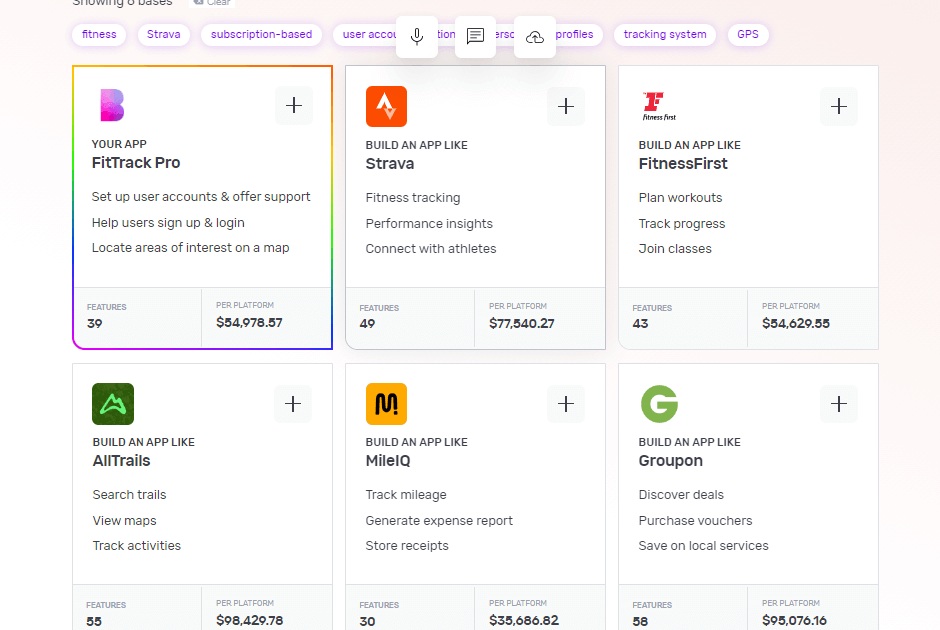
Once Natasha has your requirements, she’ll create a custom framework for your app based on everything you tell her. She'll also suggest some pre-built bases she thinks are best suited for your app.
For example, once you tell her to create an app like Strava, she’ll suggest a custom base similar to Strava and share any matching core bases as well.
You can choose up to 3 you feel are related to your big idea by simply clicking the ‘+’ icon. These selections make it easier for us to understand the features your app needs. When you’re ready, click 'Next'.
3 - Make it mine

The 'Make it mine' step aligns your app with the identity of your brand. In this step, you choose the name to your app, select its colour scheme using the colour wheel and upload the logo of your brand.
Once you’ve personalised your app’s name, colour and logo, you can click ‘Next’.
4 - Refine your app idea
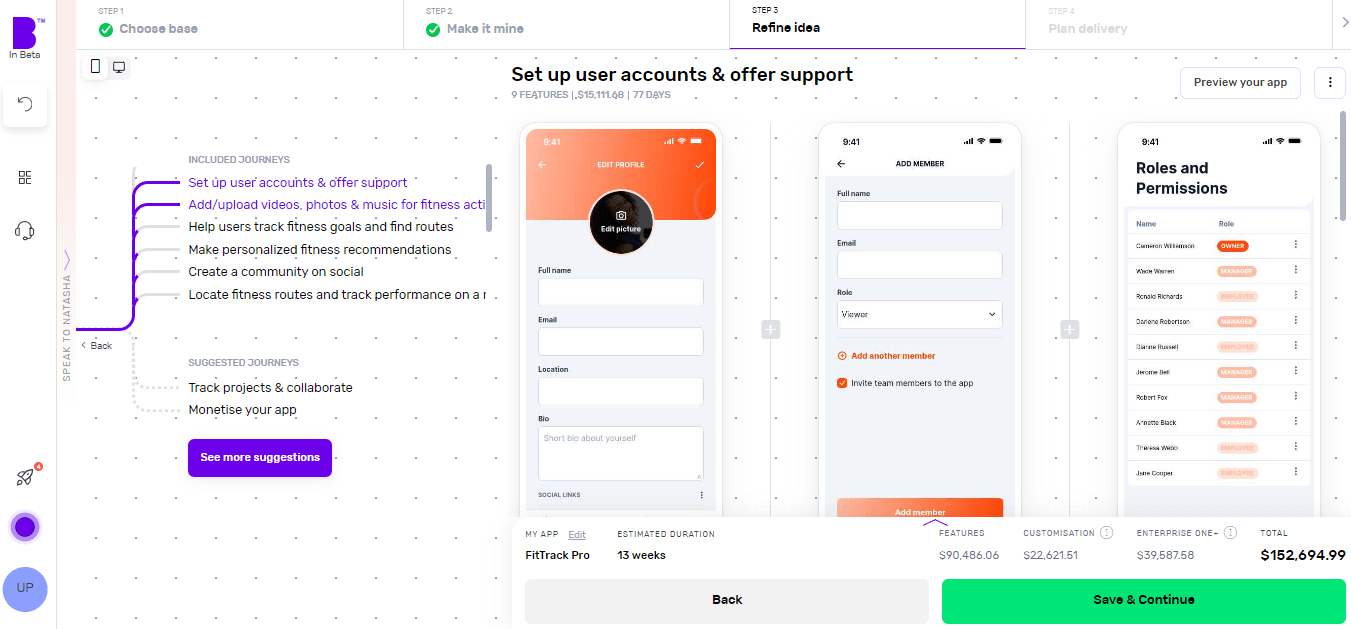
Now comes the fun bit.
In the 'Refine idea' stage, you can review and customise your app journeys and features and also create an instant prototype of your app.
Journeys
In only a matter of seconds, Natasha creates app user journeys with corresponding features.
Go through these journeys carefully and see if your app needs additional journeys. For instance, check if you want to add journeys for monetization, sending notifications or any other relevant journey.
To add journeys, click on 'See more suggestions'. Doing so will open the list of pre-built journeys. You can browse the list and select the journeys you’re missing. You can also add custom journeys by clicking on 'Add custom journey'.
Features
By clicking on individual journeys, you can see the feature list each journey contains. Doing so will open the features list each journey contains. You can scroll through the features list and check if a journey contains non-essential features or if you want to add extra features.
To remove a non-essential feature, you can hover over the feature and click ‘Remove’. This way you can manage project costs. If you’re not sure what features to remove, you can click on individual feature and check the label at the top. We highly recommend keeping the ‘Essential Features’.
In case you want to add more features, you can simply click the ‘+’ button. Here you can go through different categories or use the search bar to look for missing functionality. In case you don’t find the feature you’re looking for, you can also add a custom feature by clicking on 'Add custom feature'.
Instant prototype and user flow
Once you’re happy with the journeys and features of your app, you can create a prototype by clicking on 'Preview your app' in the top-right corner.
Sign up and Natasha will create a working prototype of your app. You can click on the screen at different areas to progress through the journey.
You can also see the user flow by clicking on the 'Flow mode' at the top of the screen to see how users will interact and navigate within your app.
If you need extra help, Natasha is on hand to help.and you can interact with her at any time by clicking on 'Speak to Natasha'.
She’ll give you suggestions and help you find features or journeys from the library. Or you can click on 'Book a demo' to talk to our product managers who’ll guide you through your app development journey.
Click on 'Save & Continue' to go to next step and also to save your progress or it might get lost.
5- Plan Delivery
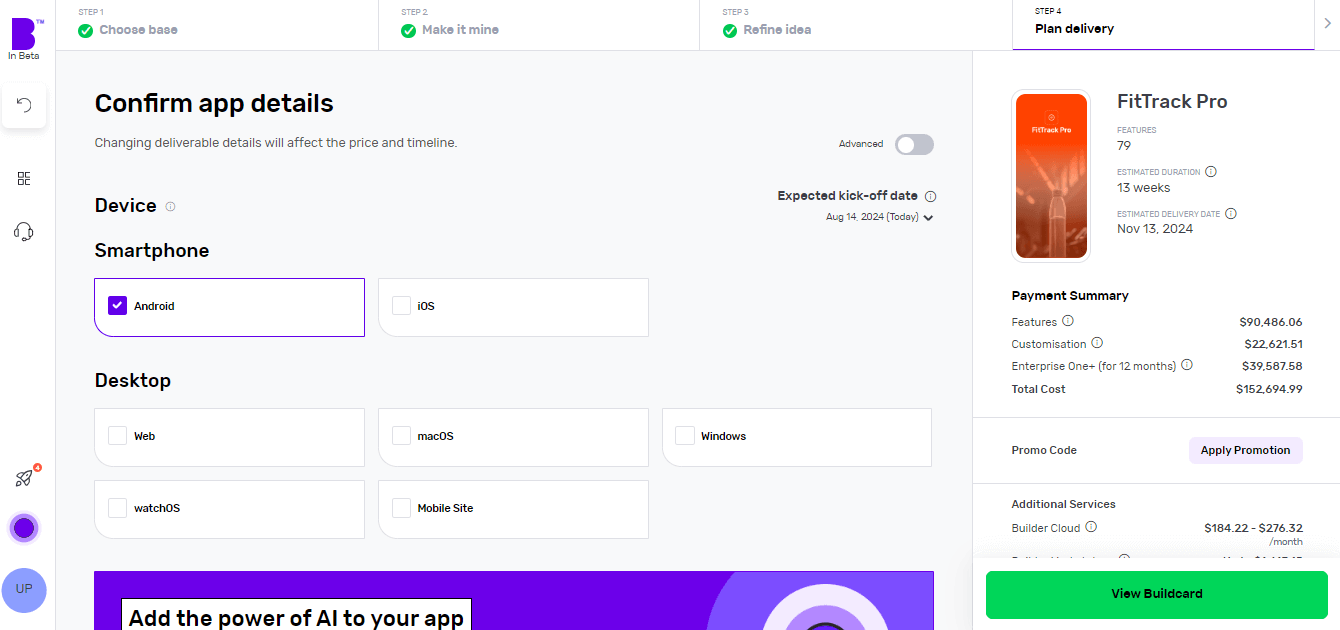
It’s time to choose the platforms you want your fitness app to be available on. Want a fitness iOS app? Click iOS. Fancy a fitness Android app? Hit Android. Not sure whether Android or iOS is better? Choose both to develop simultaneously and see how it changes the price and timelines.
Next, you can choose to add Natasha to your platform to supercharge the customer experience of your fitness app. Natasha uses Large Language Models (LLMs) to engage your customers in fluid, human-like conversations.
In the development speed section, can change the speed of each phase according to your needs. The faster the development speed, the higher the costs and vice versa.
Next up is Design. If you have your app designs ready, you can save your costs by clicking 'You have design' and we’ll reduce your costs accordingly. You can share your design files (preferably in Figma) and our designers will upload them, so you can kick off straight away.
If not, you can choose the 'We do your designs'. Here, you simply need to add your brand assets and we'll do everything from storyboarding to fully designed screens.
Now it’s time to plan the phases of your project. Here you get 3 options:
- Clickable prototype: you’ll get a visual representation of your app to test with users
- Basic build: you’ll get an MVP (Minimum viable product) – a hard-coded but simplified version of your idea. This allows you to collect feedback and iterate before you do a full build
- Full Build: you’ll get market-ready software, including a kick-off with our product team and review sessions
After that, you need to select your support plans. With 'Full Build' you get one year of Studio One support included free of charge.
Once you’ve planned your delivery, click on 'View Buildcard'.
6 - Review Buildcard
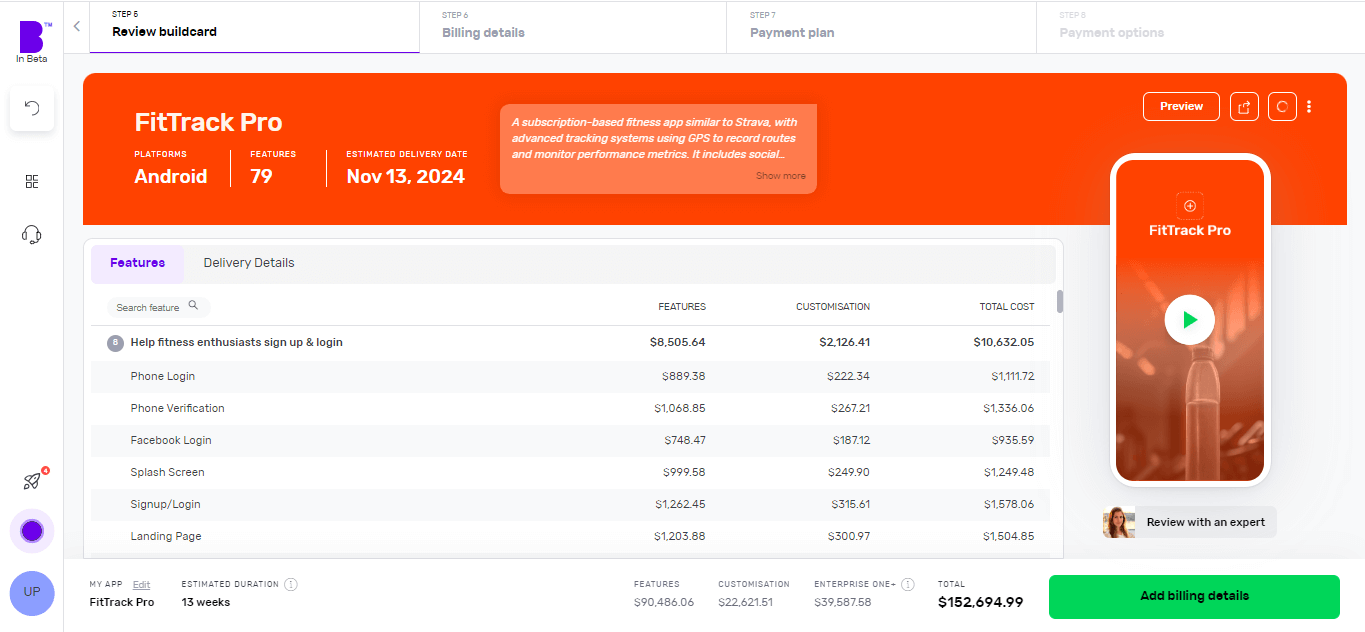
Buildcard provides you with a bird's eye view of all the selections you made in the previous steps. Here, you can review all the features, cost per feature and delivery details.
You can also download the PDF of Buildcard or invite others to show your team members what you’re building.
If you want to make any changes, simply click on 'Edit Buildcard' under the 3 dots in the top-right corner.
If you’re happy with everything, click on 'Add billing details' to go to the next section. Alternatively, if you want to review it with experts, click on 'Review with an expert'.
7 - Select your payment plan
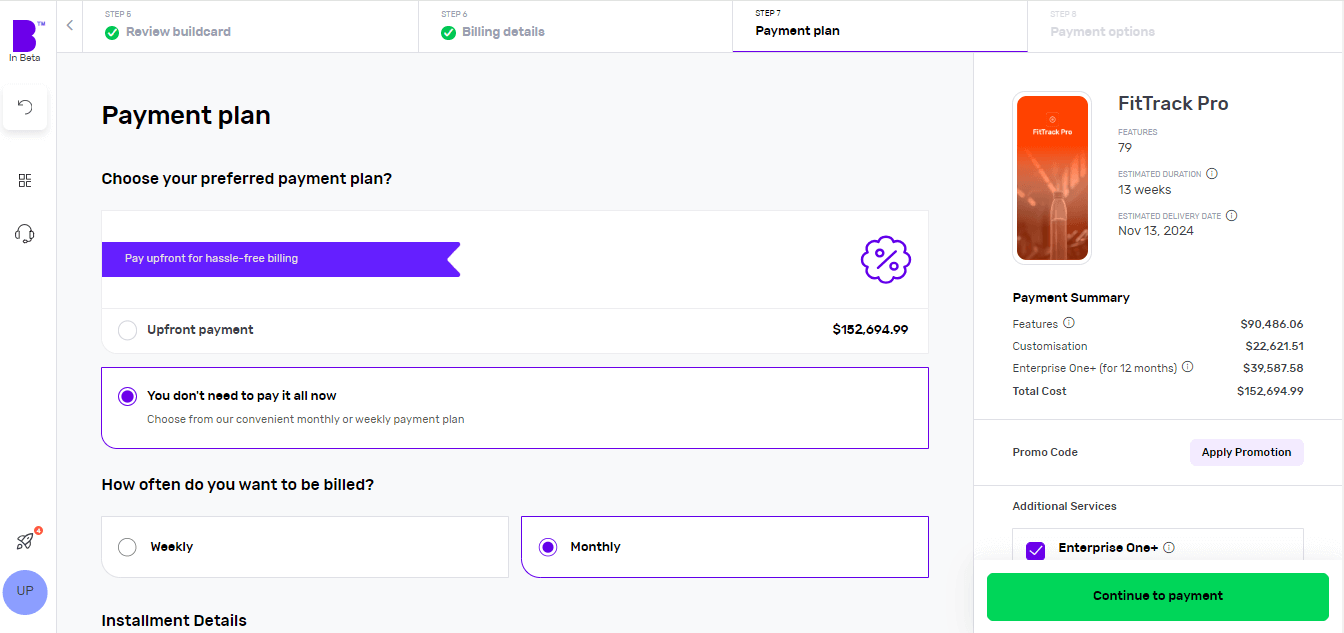
We offer weekly or monthly payment instalments, with visible payment dates and amounts for each option. You can also choose to pay upfront to reduce the cost of your build.
Simply select your preferred billing cycle, then click 'Continue' to proceed.
You’ll be asked to input your payment details and agree to the terms and conditions. Once that’s done, click 'Continue to Payment'.
Once your payment is done, you can set up a meeting with our product managers to begin your app development.
8 - Monitor your app build in real-time
With Builder Home, your real-time project dashboard, you can monitor development progress and make sure your app is exactly the way you want it.
This includes access to a suite of collaboration tools to help improve your app design. You can chat with your team of experts in Builder Meet, brainstorm in Builder Whiteboard and visualise your ideas with free Tailor-made prototypes from Builder Now.
Conclusion
Creating your fitness app isn't just about entering a competitive market; it's about better serving your users’ needse.
With the right features and a user-centric approach, your fitness platform can provide a refreshing alternative to industry giants like Strava.
Hit the banner below and kick off your fitness app project with us today 👇
Want to start your app project with us?
Book a demoSpeak with one of our product experts today.
By proceeding you agree to Builder.ai’s privacy policy and terms and conditions

Stories published by the editorial team at Builder.ai.
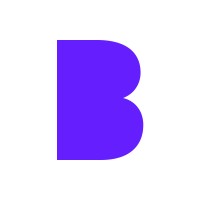
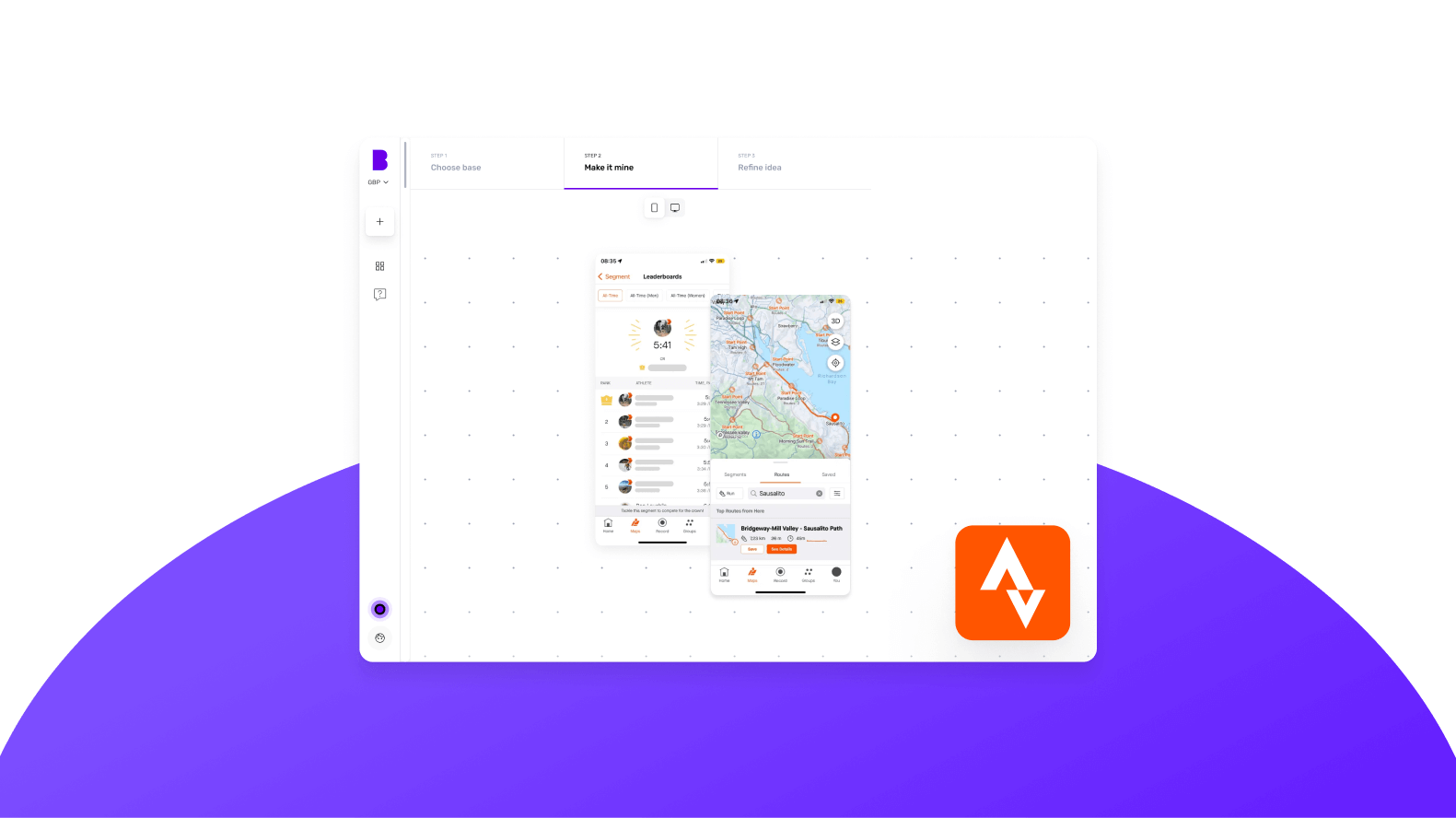








 Facebook
Facebook X
X LinkedIn
LinkedIn YouTube
YouTube Instagram
Instagram RSS
RSS


